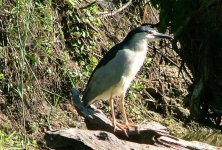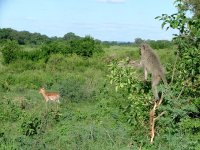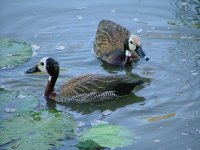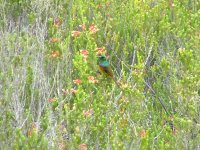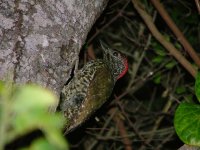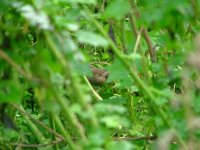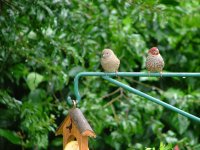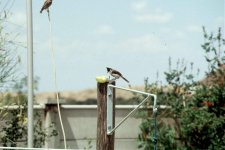-
Welcome to BirdForum, the internet's largest birding community with thousands of members from all over the world. The forums are dedicated to wild birds, birding, binoculars and equipment and all that goes with it.
Please register for an account to take part in the discussions in the forum, post your pictures in the gallery and more.
You are using an out of date browser. It may not display this or other websites correctly.
You should upgrade or use an alternative browser.
You should upgrade or use an alternative browser.
Southern African Forum (1 Viewer)
- Thread starter Dave Kennedy
- Start date
More options
Who Replied?Dave Kennedy
Well-known member
Damien, here's a few thoughts about Kruger to get the ball rolling.
Birding in the Kruger National Park (KNP) is superb. On a safety note, you may not get out of your vehicle except in the various rest camps, at picnic sites, at bird hides and at certain view sites. You can drive yourself around, so you are in no way dependent on a guide who is trying to find the Big Five for his clients. The best birding is often in the rest camps themselves, for there the birds have become used to people, and allow close approach. The same applies at picnic sites, where you can get out of your car, rent a gas cylinder for a few rand, and cook your breakfast, should you so wish. There are also excellent hides in certain areas of the park. There is a good one near Skukuza, the main camp, which is first class for water birds.
The park is broadly split into different habitats……..
1) North of Olifants Restcamp the vegetation is largely mopane veld (Colophospermum mopane), much favoured by elephant. We have always found birding in and around the Letaba rest camp to be particularly good. Both Olifants and Letaba have riverine frontage, which boosts the variety of birds significantly. Olifants is situated high on a cliff, affording spectacular views.
2) In the far north, the sandveld around Punda Maria yields many unusual tropical species, including Black-fronted Bush-shrike, and up around the Luvuvhu River to the north you can find Bohm’s and Mottled Spinetails.
3) South of Olifants the vegetation is principally Acacia thornveld, which has a good bird population. Bird parties in such habitat may yield different waxbills such as blue and violet eared waxbills, finches such as green-winged pytilia and firefinches, and beautiful starlings like the greater blue-eared glossy starling.
4) The area near Berg-en-Dal in the south-west is hilly, mountainous and rocky, with a bird and animal population suited to such habitat.
5) The larger rivers boast excellent riverine forest, with large trees such as Sycamore fig Ficus sycomorus, and Apple-leaf Lonchocarpus capassa. Giant eagle owls often roost in such trees, and the fig fruit attracts many frugivorous species, especially African Green Pigeon.
Listen at night when in camp for the Prrrrrrrrup! call of the African Scops Owl. You can often find it sitting at the fork of a branch close against the trunk. Since it relies on its camouflage, it will often allow close approach.
Whatever you do, as soon as you get to the park entrance gate, buy the best map of the KNP available, for it will show not only the roads, but all the hides, picnic spots and viewsites as well.
Watch the vultures to find lions. Circling vultures are simply using a thermal to gain altitude, but if you see vultures and/or marabou stork descending from all directions towards a single location on the ground, there may well have been a recent kill. Likewise vultures and Marabou sitting in gangs in trees suggest that the predators may still be on the kill.
You can use this map for your basic park geography. You can click on any area and enlarge it, so the detail available is reasonable.
http://www.krugerpark.co.za/Maps_of_Kruger_Park-travel/kruger-park-map-main.html
Best wishes,
Dave Kennedy
Birding in the Kruger National Park (KNP) is superb. On a safety note, you may not get out of your vehicle except in the various rest camps, at picnic sites, at bird hides and at certain view sites. You can drive yourself around, so you are in no way dependent on a guide who is trying to find the Big Five for his clients. The best birding is often in the rest camps themselves, for there the birds have become used to people, and allow close approach. The same applies at picnic sites, where you can get out of your car, rent a gas cylinder for a few rand, and cook your breakfast, should you so wish. There are also excellent hides in certain areas of the park. There is a good one near Skukuza, the main camp, which is first class for water birds.
The park is broadly split into different habitats……..
1) North of Olifants Restcamp the vegetation is largely mopane veld (Colophospermum mopane), much favoured by elephant. We have always found birding in and around the Letaba rest camp to be particularly good. Both Olifants and Letaba have riverine frontage, which boosts the variety of birds significantly. Olifants is situated high on a cliff, affording spectacular views.
2) In the far north, the sandveld around Punda Maria yields many unusual tropical species, including Black-fronted Bush-shrike, and up around the Luvuvhu River to the north you can find Bohm’s and Mottled Spinetails.
3) South of Olifants the vegetation is principally Acacia thornveld, which has a good bird population. Bird parties in such habitat may yield different waxbills such as blue and violet eared waxbills, finches such as green-winged pytilia and firefinches, and beautiful starlings like the greater blue-eared glossy starling.
4) The area near Berg-en-Dal in the south-west is hilly, mountainous and rocky, with a bird and animal population suited to such habitat.
5) The larger rivers boast excellent riverine forest, with large trees such as Sycamore fig Ficus sycomorus, and Apple-leaf Lonchocarpus capassa. Giant eagle owls often roost in such trees, and the fig fruit attracts many frugivorous species, especially African Green Pigeon.
Listen at night when in camp for the Prrrrrrrrup! call of the African Scops Owl. You can often find it sitting at the fork of a branch close against the trunk. Since it relies on its camouflage, it will often allow close approach.
Whatever you do, as soon as you get to the park entrance gate, buy the best map of the KNP available, for it will show not only the roads, but all the hides, picnic spots and viewsites as well.
Watch the vultures to find lions. Circling vultures are simply using a thermal to gain altitude, but if you see vultures and/or marabou stork descending from all directions towards a single location on the ground, there may well have been a recent kill. Likewise vultures and Marabou sitting in gangs in trees suggest that the predators may still be on the kill.
You can use this map for your basic park geography. You can click on any area and enlarge it, so the detail available is reasonable.
http://www.krugerpark.co.za/Maps_of_Kruger_Park-travel/kruger-park-map-main.html
Best wishes,
Dave Kennedy
Attachments
Last edited:
hey Guys Im also off to SA - going in a weeks time for almost 3 weeks.
have the field guides and a nikon mini scope as the leica is just too big to cart around.
staying at afton grove for a few nites and off to Phantom forest and Lanfebaan too.
also trying to get the wineries in for the other half!!
cant wait - wil post some pics on here when i return. Have also joined capebird.net - they seem a great bunch and are keen to give advice.
cheers
Nigel
have the field guides and a nikon mini scope as the leica is just too big to cart around.
staying at afton grove for a few nites and off to Phantom forest and Lanfebaan too.
also trying to get the wineries in for the other half!!
cant wait - wil post some pics on here when i return. Have also joined capebird.net - they seem a great bunch and are keen to give advice.
cheers
Nigel
Dave Kennedy
Well-known member
Hi, Nigel,
We'll look forward to hearing about your trip. Not sure where Afton Grove or Phantom forest are - although there is a Phantom Pass near Knysna. I would appreciate a little more detail as to where you will be travelling. I take it Lanfebaan is Langebaan, on the Cape west coast.
Thank you,
Dave Kennedy
We'll look forward to hearing about your trip. Not sure where Afton Grove or Phantom forest are - although there is a Phantom Pass near Knysna. I would appreciate a little more detail as to where you will be travelling. I take it Lanfebaan is Langebaan, on the Cape west coast.
Thank you,
Dave Kennedy
swiss7
Well-known member
Hey guys,
Thanks for all the info! We've pretty much sorted the trip up to the Garden Route, so spending 7 days in Kruger, then a day in Wakkerstroom, day in Mkhuze, couple in St Lucia area, travelling through Eshowe into the battlefields before doing the Sani pass.. then a long drive across to Knysna and doing that area. From there it will depend on how we feel and what we've missed out on / etc.. Probably will go up to Karoo, then back down again to the coast before hitting Cape Town.
I've got the SASOL field guide, Newmans and Callan Cohen's book.. I'll probably try pick up Roberts' in country.
Should be a good trip! We're not using guides (except for Sani pass) so might not get the biggest list ever but hoping for some good birds!
Cheers
Damien
PS: I'll contribute some photos to this forum when I get back
Thanks for all the info! We've pretty much sorted the trip up to the Garden Route, so spending 7 days in Kruger, then a day in Wakkerstroom, day in Mkhuze, couple in St Lucia area, travelling through Eshowe into the battlefields before doing the Sani pass.. then a long drive across to Knysna and doing that area. From there it will depend on how we feel and what we've missed out on / etc.. Probably will go up to Karoo, then back down again to the coast before hitting Cape Town.
I've got the SASOL field guide, Newmans and Callan Cohen's book.. I'll probably try pick up Roberts' in country.
Should be a good trip! We're not using guides (except for Sani pass) so might not get the biggest list ever but hoping for some good birds!
Cheers
Damien
PS: I'll contribute some photos to this forum when I get back
Mark Bruce
Super Moderator
Howzit Guys,Looks like the powers that be didn't like this thread in the SA Forum.
Ja, ek het dit gedoen. We decided to move this thread. If there was a specific SA Forum we would have certainly left it there. This thread was in the Information Wanted:-South Africa sub-forum. As the name suggests the forum is specifically there for members to ask for information on birding in South Africa. As we said to Mr Kennedy in our pm to him yesterday informing him that we had moved his thread and why, that we know that Local Patch isn't ideal but it's better suited to the thread than 'Information wanted' was. Additionally, it will also get more exposure here.
Cheers,
Mark
Dave Kennedy
Well-known member
Hey Alan,
Doing a bit of a whirlwind trip really.. 5 weeks visiting Kruger, Wakkerstroom, KZN, Garden Route, Cape Town, Karoo & West Coast.
Really looking forward to it!
Damien
Damien,
We’ve had a look at the Kruger Park. Now here’s some info about Wakkerstroom. The URL below is excellent. SABirding provide a great service to visitors, as you will see.
http://www.sabirding.co.za/birdspot/080606.asp
Here are some real Wakkerstroom specials:
Rudd’s lark, Botha’s Lark, Yellow-breasted Pipit, Ground Woodpecker, Southern Bald Ibis
Good Luck
Dave K
PS - My Oz list stands at 197 - not wonderful, but not bad considering they were essentially business trips. I think that, with the route you have chosen, you should beat that fairly easily.
Last edited:
Dave Kennedy
Well-known member
sorry typo
langebaan- also the phantom forest is a small reserve at knysna- expensive lodge but meant to be well worth it. Ive 'done' kenyaa dozen times but cant wait for THIS one
OK, Nigel, I now know where Phantom Forest is, and in fact a friend has a house very close to your lodge. Firstly, right there in the Lodge grounds, you should be able to find the local avian icon, the fabulous Knysna Turaco, known to everybody in the area as Knysna Lourie (or sometimes Loerie). Other specials in the area you can find on the URL below, but watch out for Knysna Woodpecker, Knysna Warbler, and Orange-breasted Sunbird, three local endemics.
Woodbourne Pan is great for waders. To find it, drive through Knysna on the road to Plettenberg Bay, and turn right at the far side of town along the road to Leisure Isle and Knysna Heads. Woodbourne Pan is on your left, just at the turn-off to Leisure Isle. It is a tidal pan, and bird population will vary with the tide.
Kranskop, a fabulous viewsite where you often see whales, is good for Orange-breasted Sunbirds (see rather poor photo). Take the road to Plettenberg Bay, and look out for the Elephant Walk Farm Stall on the right. Not very far beyond that you will see a Sasol filling station on the right, and just at the filling station a road going off right will take you to Kranskop.
Try to find a Knysna Warbler. I have attached a pic of the world' s worst sighting of a Knysna Warbler, and it drove me crazy trying to get that. They are inveterate skulkers in undergrowth, but their noisy call, an accelerating series of whistles ending in a loud trill, is distinctive.
Look out also for the Knysna Woodpecker. Take a look at the photo, and you will see that it characteristically coarsely blotched on the throat and belly, not streaked.
Beaches (which are brilliant) should yield African Black Oystercatcher, Swift Tern, Caspian Tern, White-fronted Sand plover. Estuaries and lakes may have Sandwich Terns, Greater Flamingo (particularly at Rondevlei or Swartvlei), and if the estuary mouth is open, a good population of waders. African Fish Eagles commonly occur at Rondevlei and Langvlei, between Sedgefield and Wilderness.
Note that Cape Sugarbirds like flowering proteas, so fynbos areas on higher ground will be best for them
http://www.sabirding.co.za/birdspot/010525.asp
I am sure you will have a fabulous time.
Best wishes,
Dave Kennedy
Attachments
Last edited:
Dave Kennedy
Well-known member
Dave Kennedy
Well-known member
Here's an idea..........
A garden bird list.
I live in Krugersdorp, Gauteng, on the West Rand. The list of birds seen in or from my garden currently stands at 69.
That does not include 4 exotics, namely budgerigar, cockatiel (escapees, no doubt), an Australian Red-rumped Parrot, native to NSW & Victoria, and, strangest of all, in 1990, a Red-whiskered Bulbul, native to India.
And just to show that I am not telling fibs, here is the Red-whiskered Bulbul, which came to our bird feeder over a period of several weeks.
How do other gardens compare? It would be interesting to find out. If we were to list the birds seen, it might tell us something about which birds live where, and what kinds of movement may be taking place.
Let me know what you think.
Regards,
Dave Kennedy
A garden bird list.
I live in Krugersdorp, Gauteng, on the West Rand. The list of birds seen in or from my garden currently stands at 69.
That does not include 4 exotics, namely budgerigar, cockatiel (escapees, no doubt), an Australian Red-rumped Parrot, native to NSW & Victoria, and, strangest of all, in 1990, a Red-whiskered Bulbul, native to India.
And just to show that I am not telling fibs, here is the Red-whiskered Bulbul, which came to our bird feeder over a period of several weeks.
How do other gardens compare? It would be interesting to find out. If we were to list the birds seen, it might tell us something about which birds live where, and what kinds of movement may be taking place.
Let me know what you think.
Regards,
Dave Kennedy
Attachments
Dave Kennedy
Well-known member
Re Malaria -
Some of the current prophylactics have induced unpleasant side effects in users. Anyone wishing to use such prophylactics should start using them some time before leaving for overseas to determine whether that particular prophylactic is satisfactory. Personally, we use the antibiotic DOXYCYCLIN, and have suffered no unpleasant side effects. Note also that it is important to continue taking prophylactics for the specified time after leaving the malarial area. Don't skimp on this - it is important. And finally, should you develop flu-like symptoms once you are back home, TELL your doctor that you have recently been in a malarial area. British/European doctors, in the normal run of things, are not expecting malaria in their consulting rooms, and may mis-diagnose the symptoms.
Best prophylactic of all is not to get bitten - and you can do a lot to achieve this by using proprietary bug sprays on yourself and in your accommodation. Long sleeves and long trousers in the evening are also helpful. Mosquitoes, like midgies, cannot fly in moving air, so a fan can be a great help at night to keep them away. LOOK for them before going to bed - they don't come in swarms like midgies. At most you might find one or two parking off on the wall or ceiling, and then you can blatter them with a towel or something. Remember that not all mosquitoes carry malaria - only the Anopheles mosquito - and she has a characteristic head-down posture while sitting on a wall or ceiling. Even then, it is only the female which is the carrier, and of course many of them are NOT carrying malaria. So simple precautions and sensible behaviour can go a along way to minimising your chances of contracting the disease.
It might be a good idea to contact, prior to your trip, an organisation such as the British Airways Travel Clinics, of one of the Institutes for Tropical Diseases. They will have the very latest information on available prophylactics, side effects etc.
For what it is worth we, and thousands of others, are regular visitors to Kruger. Just be sensible, and I am sure you will be fine. Kruger Park accommodation is fully mosquito-screened, so organise yourself properly and enjoy your trip.
Best wishes,
Dave Kennedy
Some of the current prophylactics have induced unpleasant side effects in users. Anyone wishing to use such prophylactics should start using them some time before leaving for overseas to determine whether that particular prophylactic is satisfactory. Personally, we use the antibiotic DOXYCYCLIN, and have suffered no unpleasant side effects. Note also that it is important to continue taking prophylactics for the specified time after leaving the malarial area. Don't skimp on this - it is important. And finally, should you develop flu-like symptoms once you are back home, TELL your doctor that you have recently been in a malarial area. British/European doctors, in the normal run of things, are not expecting malaria in their consulting rooms, and may mis-diagnose the symptoms.
Best prophylactic of all is not to get bitten - and you can do a lot to achieve this by using proprietary bug sprays on yourself and in your accommodation. Long sleeves and long trousers in the evening are also helpful. Mosquitoes, like midgies, cannot fly in moving air, so a fan can be a great help at night to keep them away. LOOK for them before going to bed - they don't come in swarms like midgies. At most you might find one or two parking off on the wall or ceiling, and then you can blatter them with a towel or something. Remember that not all mosquitoes carry malaria - only the Anopheles mosquito - and she has a characteristic head-down posture while sitting on a wall or ceiling. Even then, it is only the female which is the carrier, and of course many of them are NOT carrying malaria. So simple precautions and sensible behaviour can go a along way to minimising your chances of contracting the disease.
It might be a good idea to contact, prior to your trip, an organisation such as the British Airways Travel Clinics, of one of the Institutes for Tropical Diseases. They will have the very latest information on available prophylactics, side effects etc.
For what it is worth we, and thousands of others, are regular visitors to Kruger. Just be sensible, and I am sure you will be fine. Kruger Park accommodation is fully mosquito-screened, so organise yourself properly and enjoy your trip.
Best wishes,
Dave Kennedy
jc122463
Well-known member
Here's an idea..........
A garden bird list.
I live in Krugersdorp, Gauteng, on the West Rand. The list of birds seen in or from my garden currently stands at 69.
That does not include 4 exotics, namely budgerigar, cockatiel (escapees, no doubt), an Australian Red-rumped Parrot, native to NSW & Victoria, and, strangest of all, in 1990, a Red-whiskered Bulbul, native to India.
And just to show that I am not telling fibs, here is the Red-whiskered Bulbul, which came to our bird feeder over a period of several weeks.
How do other gardens compare? It would be interesting to find out. If we were to list the birds seen, it might tell us something about which birds live where, and what kinds of movement may be taking place.
Let me know what you think.
Regards,
Dave Kennedy
Hi Dave,
We've just started a yard list recently here. I live on the northwestern edge of Cape Town just a few blocks from the coast. We've managed 42 species so far. Our yard is really only a small patch of grass, so I wouldn't classify it as a garden at all. We have a nice little pond nearby so that adds quite a few species with those flying overhead.
This is of course not counting exotics either. I did have a Sun Conure (obviously escaped) come perch in our one small bush though! Luckilly I knew the neighbors who had lost it and was able to contact them to retrieve it.
Cheers,
Benji
My garden list is around 64. Most unusual birds: Little Sparrowhawk and Greyheaded Bush Shrike. Birds have changed over the years, no more Cape Wagtail, overrun with Redeyed Doves, Barn Owl has moved on. Neighbour chopped down all the shrubs and trees on our common boundary, so no more Garden Warbler (come to think of it, I haven't seen Willow and Icterine Warblers either this summer).
Dave Kennedy
Well-known member
My garden list is around 64. Most unusual birds: Little Sparrowhawk and Greyheaded Bush Shrike. Birds have changed over the years, no more Cape Wagtail, overrun with Redeyed Doves, Barn Owl has moved on. Neighbour chopped down all the shrubs and trees on our common boundary, so no more Garden Warbler (come to think of it, I haven't seen Willow and Icterine Warblers either this summer).
We moved into our present house in August 1989, and I think the principal change we have observed is the increase in tree-loving species as Jo'burg and its surrounds become more and more forested as garden trees mature. We are now visited daily by grey go-away-birds (louries), and at least weekly by green (red-billed) wood-hoopoes, which are particularly fond of our Acacia sieberiana (paperthorn). We have a resident pair of spotted eagle owls, and lately freckled nightjars have been calling. One, calling as he went, flew right across our garden just a couple of months ago. European bee-eaters are now migratory regulars, as are red-chested and Diderick (diederik) cuckoos. The Didericks eat the Acraea caterpillars which appear annually on our African peach Kiggelaria africana.
Dave Kennedy
Last edited:
for swiss 7 and anyone else
good website if it hasnt been posted
www.birds.sanbi.org
all the bird counts for cape area
cheers
Nigel
good website if it hasnt been posted
www.birds.sanbi.org
all the bird counts for cape area
cheers
Nigel
Dave Kennedy
Well-known member
Hey again Dave,
Thanks for all the info. The sabirding website is really a fantastic resource! Just a shame some of the info may be a bit out of date (not updated since 1998 in some cases).
Damien
Some of South Africa's birding history.....
In 1997 The first Southern African Bird Atlas Project was launched. It lasted for five years, and during that time thousands of amateur birders undertook to record, on a monthly basis, bird populations throughout Southern Africa based on quarter-degree sheet units. I myself took part in that survey, and earned myself a rarities record for black-tailed godwit near Johannesburg.
This survey resulted in the first really good distribution map of birds in Southern Africa, not only in space, but in time as well.
Things have moved on, and the second Atlas Project has begun. Here is the article on the project which appeared in the August/September 2007 issue of Africa: Birds & Birding.
"SOUTHERN AFRICAN BIRD ATLAS PROJECT 2
SABAP2 had its major launches in Pretoria on 26th June and in Cape Town two days later. SABAP1 started in 1987, and fieldwork finished in 1991. In the intervening two decades, there is no doubt that bird distributions have been on the move, driven by changes in climate and land-use and everything captured under the buzzword 'development'. SABAP2 is a partnership between the Avian Demography Unit, Birdlife South Africa, and the South African National Biodiversity Institute (SANBI).
The major changes between SABAP1 and SABAP2 is the adoption of a finer grid for the new atlas (*Note* the observation period has been cut from monthly to five-day units - Dave K.). The familiar quarter-degree grid, based on 1:50 000 maps, makes way for a five-minute grid (pentad), so there are nine 'pentads' per quarter-degree grid cell. Now, instead of having 2000 grid cells to cover in South Africa, Lesotho and Swaziland, we have 18000.
SABAP2 needs the assistance of every able-bodied birder in the region. You can register as an atlaser and get full information about the project by visiting www.sabap2.org "
I would suggest that anyone coming here on a birding holiday should contact the SABAP2 site and find out how you could best contribute. A GPS would be required to fix your pentad - and away you go!
Let me know what you think.
Dave Kennedy
PS, Nigel, thanks for that Cape birding site.
D.
Last edited:
Similar threads
- Replies
- 12
- Views
- 880
Users who are viewing this thread
Total: 2 (members: 0, guests: 2)




